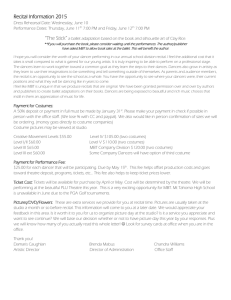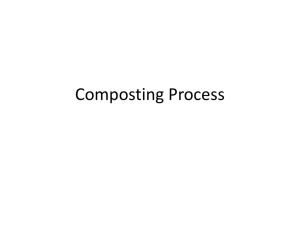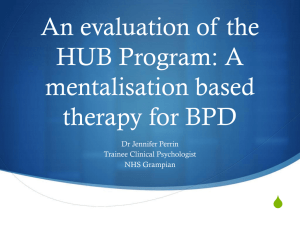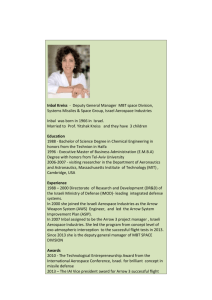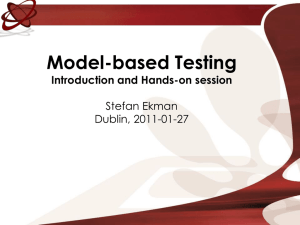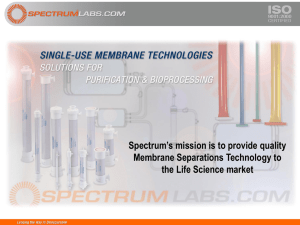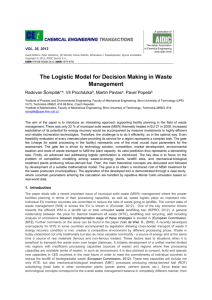DESCRIPTION DES MBT
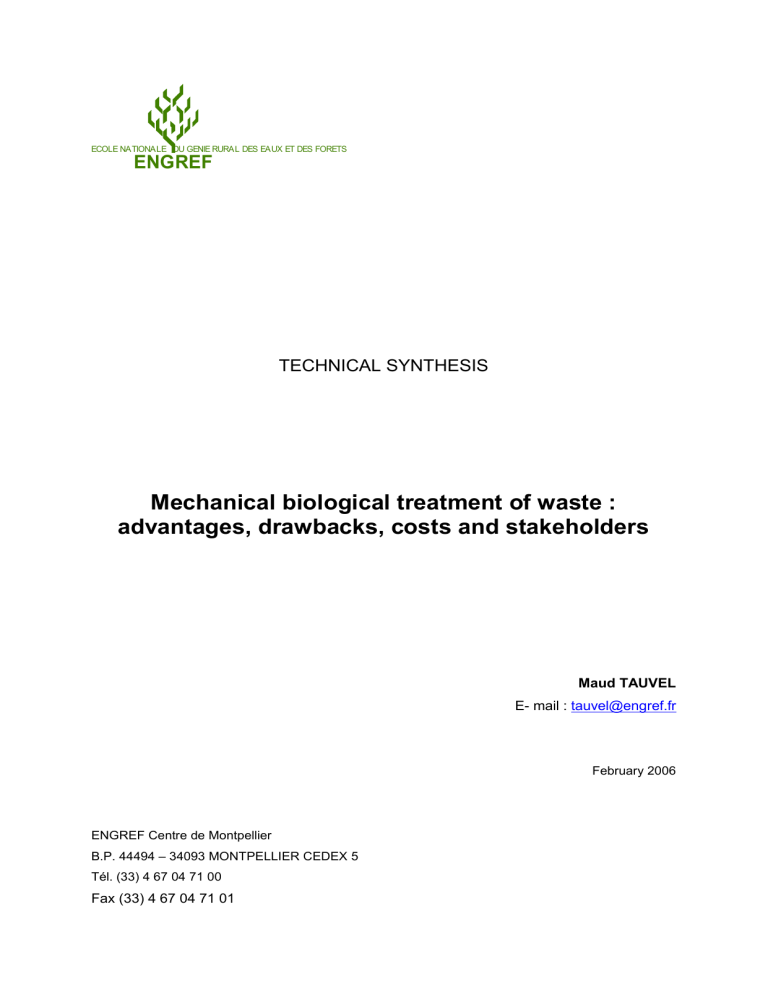
ECOLE NATIONALE DU GENIE RURAL DES EAUX ET DES FORETS
ENGREF
TECHNICAL SYNTHESIS
Mechanical biological treatment of waste : advantages, drawbacks, costs and stakeholders
Maud TAUVEL
E- mail : tauvel@engref.fr
February 2006
ENGREF Centre de Montpellier
B.P. 44494 – 34093 MONTPELLIER CEDEX 5
Tél. (33) 4 67 04 71 00
Fax (33) 4 67 04 71 01
RESUME
Le traitement biomécanique des déchets (MBT) regroupe différents procédés de traitement des déchets ménagers qui associent des traitements mécaniques comme le criblage ou le broyage à des traitements biologiques de type compostage ou méthanisation. Les produits obtenus sont fonction des techniques utilisées : compost, biogaz, combustible, divers matériaux recyclables, fraction stabilisée biologiquement pouvant être mise en décharge.
Les MBT se sont développés dans certains Etats Membres principalement sous l’impulsion de la directive européenne sur la mise en décharge et en raison du refus croissant des populations d e l’incinération. Des arguments économiques en cas de faible tonnage à traiter sont également mis en avant, ainsi que des avantages environnementaux (limitation des effets négatifs dus au stockage de matière organique MO).
En revanche des réticences émanant principalement du secteur privé invoquent son manque de sûreté économique, en raison de la difficulté à trouver des débouchés pérennes aux produits des MBT. Par ailleurs, la diminution des quantités de MO enfouies n’est que partielle, ce qui limite leur intérêt environnemental. Enfin les incertitudes réglementaires qui planent sur les MBT et ses produits n’encouragent pas leur développement.
Le recours aux MBT doit donc être réfléchi en fonction du contexte local, et notamment les débouchés possibles pour leurs produits.
MOTS CLES
Traitement mécano biologique ; pré-traitement biologique ; compostage ; méthanisation ; ordures ménagères résiduelles ; combustible dérivé de déchets ; biogaz
ABSTRACT
Mechanical biological treatment is a generic term for a large number of processes which process household waste by mechanically removing some parts of the waste (thanks to sorting or sieving for example) and by biologically treating others (anaerobic digestion and composting). MBT generates different products, according to the processes used : compost, biogas, refuse derived fuel, stabilised residu to landfill.
MBT has been developed in several countries in Europe, mainly due to the European Landfill
Directive and to the increasing disapproval of incineration from consumers. Moreover, in cases of low quantities of waste, MBT has advantages economically and environmentally.
(decrease in the negative impact on landfilling from organic matter).
However, private companies are a little bit reluctant to use MBT because of the difficulty of finding viable market outlet for the output. Furthermore, the decrease in the quantities of organic matter going into landfills is only partial, so the environmental interest is not so high.
Lastly, there still are some uncertainties about regulatory and policy issues about MBT, which do not favor its development.
The use of MBT has to be considered within its local context, and especially availability of outlets for the products.
KEY WORDS
Mechanical Biological Treatment ; stabilisation of waste for landfilling ; composting ; anaerobic treatment ; residual municipal waste ; refuse derived fuel ; biogas
1
Due to the European Landfill Directive 1999/31/CE, State Members have to decrease the amount of biodegradable waste landfilled. In order to meet their landfill diversion targets, countries have developed strategies based on different technologies and statutory tools. In
France, the importance of incineration will permit to meet the European targets, but several countries have decided to develop mechanical biological treatment.
DESCRIPTION OF MBT
DEFINITION
Mechanical biological treatment is a process that processes waste by mechanically removing some parts of the waste and by biologically treating some others. The residual fraction is smaller, more stable and more suitable for a number of possible uses.
In fact, MBT gather several types of mechanical and biological processes that are combined in a wide variety of ways, to meet a range of objectives.
Mechanical treatment
This achieves the mechanical separation of waste into potentially useful products and/or into streams suitable for biological processing.
The mechanical treatment has the following functions (Kuehle-Weidemeier, 2004) :
Separation and conditioning of contraries
Separation of the high calorific fraction for the use as refuse derived fuel, by sieving and air separation
Separation of waste components which can be recycled, thanks to magnetic separator.
Disintegration and homogenisation of the waste for the biological treatment, thanks to shredders and mixing drums.
Biological treatment
Biological processes convert the biodegradable fraction into a compost-like output and/or in biogas and/or stabilised fraction to be landfilled.
Aerobic treatment
The most simple way of biological treatment is mainly to passively aerate piles under a roof, which are shifted from time to time. But the biological process can also be done in actively aerated and frequently shifted piles located in halls or in composting tunnels, which allow a better process and emission control (Kuehle-Weidemeier, 2004).
Anaerobic treatment (digestion)
The digestion can be designed in two different ways :
The full stream digestion processes the whole waste stream that is biologically treated. The advantage is the use of the whole methane production potential.
The part stream digestion includes just a fine fraction, while the rest (which contains many anaerobically poorly degradable substances) goes directly into the aerobic treatment (Kuehle-Weidemeier, 2004).
The two types of biological treatments can be used alone and combined.
2
THE VARIOUS MBT
Use of MBT
MBT, like other residual waste treatment processes (pyrolysis, gasification, bioreactor…) aim at increasing rates of recycling and at reducing the volume of material for final disposal like incineration and landfill and their environmental impacts (Greenpeace Environmental Trust,
2003).
MBT plant will vary according to two main factors :
Kind of waste to be processed (residual waste, raw waste, mixing with sewage sludg es…)
The final disposal of waste (landfill, thermal treatment).
MBT outputs
According to the waste treatment processes chosen, MBT allow the removing of recyclable parts and the production of a high calorific fraction, which can be used as a fuel (refused derived fuel or RDF), biogas, and/or compost and /or a stabilised residue. MBT can be used in order to produce a variety of outputs so the MBT process has to be chosen according to the kind of products you want to obtain.
Figure 1 summaries the outputs.
Inputs Mechanical Biological Treatment Outputs
Mixed waste
Source separation
Mechanical
Treatment
+
Recyclable
Material
Rejects streams
Refuse derived fuel
Incineration /
Landfill
Residual waste
Biological
Treatment
Aerobic treatment
(composting)
Compost
Compost-like output
Stabilised residue
Landfill
Anaerobic treatment
(digestion)
Biogas
+
Digestate
Figure 1 : Outputs of mechanical biological treatments
Landfill
Composting
3
MBT products can be used in various ways ( Ошибка! Источник ссылки не найден.
).
Outputs
Compost-like output
Solid fuel
Biogas
Stabilised residue
Application
Fertiliser, on crops, for use in domestic gardens ; on contaminated land
Co-fuel for combustion in power plant, co-fuel for cement kilns, co-fuel in dedicated incinerator
Produce electricity, produce a transportable fuel, blend with other gas
Landfill
Table 1 : Main uses for MBT output
THE AMBIGUITIES OF THE TERM
The term MBT regroups a range of processes, which really vary from one to another. That is why there is a lot of misunderstanding.
In this report, MBT will be considered in its extensive meaning, that is to say treatments that associate a mechanical step to a biological step, and which aim at minimising the environmental impacts linked to the final disposal of waste and obtaining added value from the waste thanks to the recovery of some materials.
CURRENT OFFER
MBT can be used for processing of mixed household waste or of residual waste. Plants are consequently fitted to deal with the kind of input waste.
Among the 27 companies which provide the MBT process reviewed by Consultancy Services
Ltd (Juniper Consultancy Services Ltd, 2005a), there are 80 operational MBT facilities, that is to say a treatment capacity of more than 8.5 millions Tpa. In addition, these companies have announced a further 43 MBT projects, so the expected installed capacity by 2006 is
13 000 000 Tpa.
Spain, Italy, Austria and Germany are part of the the most advanced countries in MBT but
several European countries now use these technologies (Figure 2).
Figure 2 : Installed capacity of operational facilities by location (Juniper Consultancy Services
Ltd, 2005a)
The process developed by theses companies produce different outputs (Table 2).
4
Primary output
Soil
Biogas
Landfill
Fuel
Operating capacity (thousand Tpa)
2700
2500
2200
1300
Operating capacity (%)
31
29
25
15
Table 2 : Capacity of operational MBT plants by primary output (Juniper Consultancy Services
Ltd, 2005a)
Treatment capacity of MBT plants varies between 10 000 Tpa and 250 000 Tpa (Friends of
the Earth, 2004), most plants having a treatment capacity under 100 000 Tpa (Table 3). No
MBT facilities have yet been built at a scale comparable to the largest incineration facilities
(more than 500 000 Tpa).
Input capacity
Number of facilities (%)
< 50 000
22
From 50 000 to 100 000 From 100 000 to 200 000 > 200 000
38 26 14
Table 3 : Scale of operating facilities (Juniper Consultancy Services, 2005a)
ECONOMICS OF MBT
There is little available data about the topic especially in France where there are very few operational MBT facilities.
Capital cost
Two facilities with different input capacities, using a different process in different backgrounds will have really different capital cost. So comparing capital cost is really difficult
(Greenpeace Environmental Trust, 2003). Moreover, very little data is available, because companies do not always want to provide these kinds of figures. But it seems that MBT capital cost are generally lower than for incineration (Juniper Consultancy Services Ltd,
2005a).
For example, the facility of Mende (stabilisation of waste for landfilling), whose input capacity is 30 000 Tpa, is worth 4.5 million € (Llinas L., 2005) ; the MBT facility that Angers Loire
Métropole wants to build, based on an input capacity of 91 000 Tpa, with half the waste going into anaerobic digestion after the preparation, has been estimated at 25 million €
(Bader C., 2006). Greenpeace Environmental Trust estimates the cost of a facility with an input capacity of 100 000 Tpa at nearly 45 million € (Greenpeace Environmental Trust,
2003).
Table 4 gives a few figures for abroad facilities.
Supplier Process Scale (Tpa)
Bedminster 200 000
Capital cost (million
€/year)
70
Treatment cost/ Gate fee
(€/t)
47
Civic
Global Renewables
Continuously agitated aerobic composting
Composting
Percolation and in hall composting
90 000
200 000
19,5 à 22,5
52 à 67
52,5 à 90
60 à 90
Hese
ISKA
Two-step thermophilic anaerobic digestion
Percolation, anaerobic digestion and composting
112 000
150 000
45
40 70
5
Linde
SBI
SRS
VKW
VKW
Composting and anaerobic digestion
Anaerobic digestion
Tunnel composting
In-hall composting
In-hall composting
140 000
220 000
26 000
75 000
150 000
36
38
3,75
16,5
27
90
52,5 à 60
Table 4 : Investment and gate fee costs provided by suppliers (Juniper Consultancy Services
Ltd, 2005b)
Treatment costs
The MBT treatment cost might be around 45 to 90
€/t (Table 4). It is worth 80 € /t in the
Mende facility (total cost including transport, treatment and landfill disposal) (Llinas L., 2005).
A preliminary study ordered by SYTRAD (facility including compost and fuel production) has estimated the treatment costs at around 90
€/t (Poncelet F., 2005).
Costs really vary according to the countries (Table 5), because kinds of waste and the
developed treatment processes are different.
France Germany Holland Spain
England and
Wales
Treatment cost
MBT (€/t)
80 80-100 80-100 30-35 45-90
Table 5 : MBT operating costs according to the countries (Dunet et al., 2004)
Indeed, operating costs considerably vary due to the large flexibility and the diversity of treatments they entail. Besides, they also vary according to the input waste quality and the
kind of products (Table 6 ). For example, let’s look at the case of a facility which produces
biogas used for energy and which succeeds in finding for its digestate an outlet that does not cost anything : this facility can have its treatment cost decreased at the rate of 3.5 to 40 €/t.
On the other hand, if a facility does not manage to find a viable outlet for its compost which has to be landfilled, an additional cost of 10 to 38 €/t can be seen.
Products
The potential impact of MBT outputs on a facility’s gate fee
( €/t of input waste)
Ferrous metals
Aluminium
Light plastics
RDF
Biogas
Compost like outputs
Stabilised residue to landfill
From - 3 to- 6
From - 3.5 to - 6
From – 3.5 to + 7.5
From - 2 to + 40
From – 40 to – 3.5
From
– 3.5 to + 37
From + 10 to + 38
Table 6 : Impact of MBT outputs on a facility’s gate fee (Juniper Consultancy Services Ltd,
2005a)
THE REASONS FOR THE DEVELOPMENT OF MBT
REGULATORY ISSUES: EUROPEAN LANDFILL DIRECTIVE 1999/31/CE
The targets of this directive are percentages of biodegradable household waste to be landfilled compared with the total quantities of biodegradable waste generated in 1995.
6
To meet these statutory targets, Member States have to select technologies that will enable to divert waste from landfill.
Incineration is a possible treatment and has been chosen by France, where MBT has not been developed very much. But several countries want to develop or at least want to consider the possible use of alternative technologies like MBT, which decrease the quantity of biodegradable waste landfilled (Remond G., 2005).
In Germany, the national regulation is even more restrictive than the directive’s targets : thresholds on total organic carbon (TOC) have been set for input waste in landdfill (5 %), which explains the big development of MBT in this country (Budka A. et Martin I., 2005 et
Lagier T. et Redon E., 2005).
Such standards for waste allowed to be landfilled have been set up in Austria (standards of
TOC, calorific value, AT
4
, GB
21
) (Hébé I., 2005a).
ENVIRONMENTAL ISSUES : LIMITATION OF THE NEGATIVE IMPACT OF
BIODEGRADABLE WASTE LANDFILLING
The decrease of the biologically active part of waste thanks to mechanical biological pretreatment before landfilling is a way of limiting the environmental impacts linked with waste landfilling (Sidaine J.M., 2003) :
A decrease in the production of biogas in landfills. Even if the biogas has to be kept in landfill sites, some of them still let large quantities of biogas escape into the air. The first results of a trial conducted by CREED on a pilot site seem to show that stabilised waste still emited biogas 2 years after landfilling. But the biogas production was really fast, the pilot site having nearly run out of its potentiel of methane production in 2 years (Lagier T. et Redon E., 2005)
A decrease in the organic pollution of infiltration water and consequently a limitation of the cleaning costs and an avoidance of scaling pipes.
A decrease in compacting phenomena, which limits the risks of damaging the technical installations (pipes, waterproofing systems…).
A suppression of heat release which can damage sealed systems.
Thus in Austria, where MBT is well developed, the choice of this kind of treatment has been made in order to reduce the risks linked to andfil l for future generations (Hébé I., 2005a).
So people and environmental organizations often do better with mechanical biological pretreatment before landfilling.
Lastly, let’s notice that environmental interests are linked to regulatory issues : the landfill directive has notably been drawn up in order to reduce the biogas emissions from landfill.
SOCIAL ISSUES : ACCEPTABILITY OF THE TREATMENT
Problems with incinerators (notably dioxines) have made incineration really unpopular to people. Anyway, projects of landfill sites or incinerators are often stalled by environmental groups (Rémond G., 2005). That is why elective representatives try as much as possible to avoid incinerators (Lagier T. et Redon E., 2005, Llinas L., 2005 et Poncelet F., 2005). This has led to a new lease of life in the interest for alternative treatments, which include MBT
(Greenpeace Environmental Trust, 2003, Budka A. et Martin I., 2005).
The failure of mixed waste composting, mainly due to the difficulty to obtain valuable products, also support the development of MBT (Chalot F., 2005 et Gal A., 2005) : the aim of the mechanical part of the process is to optimize the material for the biological processes
(Greenpeace Environmental Trust, 2003).
7
ECONOMIC ISSUES
Flexibillity of the process
Local authorities that have chosen MBT to process their waste praise their economoic advantage compared to incineration as far as low tonnages are concerned : MBT facilities are smaller and more flexible (Lagier T. et Redon E., 2005) and they can withstand seasonal variation of input waste quantities (Llinas L., 2005). To build small scale facility allows for example to avoid the long-distance transport cost of waste (Friends of the Earth, 2004).
Extension of the life of landfill
Mechanical biological pretreatment of waste before landfilling brings about a loss of weight, due to a decrease in the organic matter and in the water content. Moreover it increases the density of waste landfilled. So the volume landfilled can be reduced from 50 to 60 % and the tonnage from 19 to 35 % compared with non-stabilised waste (Ademe, 2001). For example, trials led in the mechanical biological pretreatment facility of the SMITOM Launay-Lantic
(Morvan B. et al., 2004) have shown that landfilled flows can be reduced by 58.6 %, thanks to a recovery by production of compost (34 %), a recycling of metals (0.89 %) and a loss of biodegradable matter of 27.2 % (among them 3.5 % of added water).
So the life of landfill sites can be significantly prolonged thanks to mechanical biological pretreatment. Consequently the local authority saves money, because it does not need to build other treatment plants (Rémond G., 2005).
Importance of outlets
Some MBT can have interesting market outlets.
Thus MBT could be a way not to close facilities of mixed household waste composting, whose compost does not find any outlet. In this context, the potential market could be important (Dunet D. et al., 2004). Moreover, if you want to biologically re-use your waste, the cost of the reconversion of the old facility can be lower than the cost of the installation of a selective collect of biological waste (Ademe Délégation Bretagne et al., 2001).
Moreover, a compost-like output can be interesting if the fee you pay for the outlet is lower than disposal cost. That seems to be true in forestry, in landscaping, on brownfield sites or for use in arid regions (Juniper Consultancy Services Ltd, 2005a).
Finally, MBT-derived fuels are cheap and not seasonal. They can be produced in big quantities all the year long, contrary to others fuels. This can make this output interesting : their use in cement kilns could be increased (Juniper Consultancy Services Ltd, 2005a).
DEVELOPMENT OF MBT ABROAD
Countries that mostly use MBT are not influenced by the same factors :
- Spain has developed MBT producing mainly compost-like outputs, in order to improve arid lands, and biogas (Coste E., 2005).
- In Italy, the prefered outlets are landfill or the production of fuel, in order to avoid incineration. As far as landfill is concerned, there is often stabilisation before landfilling, which allows to limit the release of odours during landfilling (Coste E., 2005).
- Germany has chosen the same outlets as Italy, also in order to avoid incineration and because landfilling of biodegradable waste has been reduced by the threshold on input waste (Budka A. et Martin I., 2005).
- In Austria, the developement of MBT is mainly due to regulatory issues (thresholds on the organic matter content and on the calorific value of input waste) (Hébé I., 2005a).
8
THE FACTORS CONSTRAINING THE DEVELOPMENT OF MBT
ECONOMIC ISSUES : COSTS AND OUTLETS
Existence of viable market outlets for MBT products
The main difficulty is the concerns about the long-term marketability of the ouputs from the
MBT process, which dissuades the operators from developing MBT. But the marketability issues vary, depending on the type of output. The least secure markets are those concerning compost, compost-like outputs and RDF (Juniper Consultancy Services Ltd, 2005a).
As far as compost is concerned, the main issue is the quality of the product. The market is not very keen on using these kinds of products for several reasons (Juniper Consultancy
Services Ltd, 2005a) :
- Users of compost react very negatively if they see any visual contamination within the product (for example plastic film)
- presence of heavy metals higher in the ouptut from MBT plant than compost derived from source separated green waste. This is why the food industry are reluctant about using this compost on land used for growing food crops. So you have to be sure that the selective collect upstream prevent having hazardous waste of small size like batteries in the residual waste processed by MBT (Lagier T., et Redon E., 2005)
- still no certification
- high level of competition with compost from green waste and biowaste, perceived as having a better quality (Le Boulanger P., 2005). A study about the re-use of organic matter made for three Breton local authorities responsible for the waste management have shown that you can find outlets for 42 000 Tpa for the MBT-derived compost (on brownfield sites, for landscaping in road construction and vegetables crops, whereas you can find outlets for 61 000 Tpa for compost derived from biodegradable and green waste, that can also be used for park s, and vegetable gardens (ADEME Délégation Bretagne et al., 2001).
Thus whereas in 1993, 90 % of the composted waste were mixed household waste, in 2000, only 45 % of composts are derived from this type of waste, to the advantage of green waste composting (ADEME, 2000).
As far as RDF are concerned, the most constraining factor for the operators is still the lack of viable long-term markets for the fuel in cement kilns power plants which can use other fuels than fossil hydrocarbons (SITA, 2004) : MBT-derived fuel are heterogeneous, they contain heavy metals and there are sometimes odour problems due to their degradation during the storage, which makes them quite unpopular (Juniper Consultancy Services Ltd, 2005a).
Finally, the outlets are linked with the lo cal context (presence of crops, cement kilns,…), which explains why you can not generalize at a national scale the interest of one process in particular. For example, a process that produces compost will only be intersting in areas of crops, otherwise the compost will have to be landfilled (Budka A. et Martin I., 2005). Resort to this kind of process, without any regulatory constraint like you can find in Austria and in
Germany or without any financial encouragement, should be thought of in terms of local issues : thus in Spain, compost have no difficulty to find a use, due to the presence of arid lands.
Treatment costs
MBT is a quite expensive process compared with the other biological treatments (Figure 3).
9
Green waste composting
Biowaste composting
Sorting
– composting of mixed waste
50-70
Anaerobic digestion alone
MBT
Treatment costs
(€/t) in 2004
40-55 50-70 60-70 80
Figure 3 : Treatment costs of biological process in France (Dunet D. et al., 2004)
For the operators, there is a lack of data concerning the costs of this process, this is why they are reluctant to really develop it (Budka A. et Martin I., 2005).
Not a complete treatment of waste
MBT is not a final disposal for waste : you still have to use another process such as incineration or landfilling for the residual part, which can represent quite an important added cost that can dissuade collectivities (Budka A. et Martin I., 2005, Chalot F., 2005).
ENVIRONMENTAL IMPACTS
Limitation of the organic matter flows landfilled
The use of MBT can allow to significantly reduce the quantities of biodegradable waste landfilled only if there really exists an outlet for the ouput on the market. Moreover,
performances really vary within a process (Table 7).
Configuration goal
Stabilisation of output for landfilling
Make a compost
Make a soil improver
Make a RDF
MBT to reduce the need for thermalt reatment
Producing biogas with digestate to landfill
Producing biogas and a soil improver
Estimated diversion rate from landfill (%)
When the output finds a market
When the output does not find any market
24 to 90
82 to 90
87 to 92
90 to 95
85 to 92
14 to 61
79 to 85
34 to 83
6 to 79
6 to 70
28 to 79
Table 7 : Diversion performance (Juniper Consultancy Services Ltd, 2005a)
As far as mechanical biological pretreatment is concerned, there is an important lack of data about the impacts in landfill sites and also about the performances of this type of process in
France (Hébé I., 2005b). Even in Germany and in Austria, where mechanical biological pretreatment is more developed, no landfill site has received only stabilised waste (Lagier T. et Redon E., 2005).
This is why Ademe has launched a monitoring programme about the Mende facility, which was the first operational mechanical biological pretreatment facility in France.
Two monitoring steps are planned, the end of the study being in 2006. After having examined the input waste, a monitoring of different parameters (gas production, leachate production, compacting phenomena) and an analysis of the changes in organic matter that happen during the pretreatment have been realised.
The results of the first campaign (not pubished yet) do not seem to be so good : there is still a lot of organic matter after the pretreatment, so that the environmental impacts are still high.
But improvements concerning odours seem to have been noted (Hébé I., 2005b). Besides,
10
some operators have developed processes of mechanical biological pretreatment that allow to avoid the emanation of odours, by trying not to eliminate the whole quantity of organic matter that can produce biogas during landfilling (Coste E., 2005).
But this lack of performance is often criticized and does not encourage to keep this solution
(Lagier T. et Redon E., 2005). On the Mende facility, where waste is pretreated, only 30 % of the flow (weight) would be diverted from landfilling, which is not as good as what you could have diverted thanks to an intensive selective collect (Budka A. et Martin I., 2005).
Greenhouse gas production
A study launched in 1994 by the Umwelt Bundes Amt, the federal agency for environment in
Germany, has compared 15 environmental impact studies made by different organisms and specialised consultancies. The basis of every study was a comparison of greenhouse gas production by incineration and by the pre-treatment + landfilling.
Here are the results :
7 studies have given an ecological advantage to incineration
6 studies have given an adavantage to pre-treatment
2 studies have found both process equivalent.
The study concluded that the differences between the 2 processes, in particular the impacts linked with greenhouse effect, are very small.
Nevertheless, all the studies agree to say that pretreatment and incineration are both an important reduction in the greenhouse effect compared with landfilling without any pretreatment (Greenpeace Environmental Trust, 2003, Sidaine J.M., 2003).
Energetic consumption
From an energetic point of view, aerobic mecanical biological pretreament would be less favourable than simple landfilling or treatment in bioreactors, due to the big consumption of energy for aeration (Lagier T. et Redon E., 2005). So the optimum of biological stability should be looked for, because the more you try to biologically stabilise the waste, the higher the energetic consumption (Aoustin E. et al., 2005).
REGULATORY ISSUES
Uncertainties on regulation
The developement of the process comes up against the lack of regulation about mechanical biological treatment, and specifying the characteristics of a stabilised waste (Dunet D. et al.,
2004). That is why most of the stakeholders are waiting. Indeed they do not want to develop a process without knowing what the regulatory issues will be.
Thus, the draft of the European Biowaste Directive has not been finalised so that the standards and protocoles for the use on land of compost-like output derived from waste pocessing facilities have not been given at EU-level (Juniper Consultancy Services Ltd,
2005a). This directive could reduce the use of the term “compost” only to the products from source-separated waste and not mixed waste (SITA, 2004). Moreover, even if the biodegradability of waste has been considerably reduced by the process, it is still not clear that the stabilised waste can be classified as inert (Friends of the Earth, 2004).
Moreover, the Soil Strategy has been delayed so that the guiding principles about the use on land of waste-derived materials are still expected. Its absence increases the already significant uncertainties about which usage options are acceptable.
11
The Best Available Technology Reference for waste treatment has still not been finalised : the local regulators can not determine whether or not MBT projects are compliant with the
Integrated Pollution Prevention and Control Directive, so that operators would prefer more established waste processing technologies (Juniper Consultancy Services Ltd, 2005a).
Uncertainties also hang over the use of biogas and RDF : it is not clear if the combustion of biogas in power plants should respect the Incineration Directive and standards about RDF have not been published yet.
Lastly, RDF and compost-like outputs derived from MBT are still considered as waste, which do not make their use on the market easy.
Lack of regulatory encouragement
The implementation of thresholds about the organic matter content for waste to be landfilled in Germany and in Austria is one of the main factors that explains the development of MBT in these countries (Lagier T. et Redon E., 2005). But in France, no policy going further than the
European Directive compliances has been decided, so that MBT is not often chosen as the best solution to treat waste (Redon E. et al., 2005 et Rémond G., 2005).
But finally, even in Germany where MBT have really been encouraged by a regulation, MBT is a transient solution. Indeed the government has decided to ban waste landfilling from 2020
(Lagier T. et Redon E., 2005).
MBT AS A PART OF WASTE MANAGEMENT
The aim of MBT as a waste management tool is to minimise the environmental impact associated with the end disposal of biodegradable waste and to obtain additional value from the input waste by recovery of recyclable materials such as metals, glass, compost and sometimes biogas and a waste-derived solid fuel fraction (Juniper Consultancy Services Ltd,
2005a).
MBT can be integrated in a current waste management strategy, since operational facilities can adapt to a large number of circumstances.
UPSTREAM : SELECTIVE COLLECT
MBT are complementary to selective collection : the residual part, which represents at least
50 % of waste, can be treated by MBT in order to be stabilised before landfilling (Bajeat P.,
2005).
Moreover, the use of MBT in order to make compost enables to have higher recovery rates higher than what you could have reached with source-separated biowaste, the cost being lower in the case of composting facilities that just need to be adapted. Indeed, selective collection is expensive and the whole flow of organic matter is not caught by a selective collection of biowaste. So MBT can be an interesting tool for local authorities which try to maximize the rate of organic recovery (Ademe Délégation Bretagne et al., 2001).
THE PROCESS
Biological pre-treatment can be used to process sewage sludges at the same time as residual household waste. This can be useful in urbanized areas with high popultion rate, where spreading of sludge or compost derived from sludge is not easy (Greenpeace
Environmental Trust, 2003).
DOWNSTREAM : LANDFILLING AND INCINERATION
Like the other processes of residual waste, MBT is complementary to prevention and recovery. In the framework of a comprehensive and varied approach, this recent process can
12
be used to process waste upstream landfilling or incineration, in order to limit or to optimize the use of these treatments (Bajeat P., 2005).
At the end of the mechanical biological treatment, around two thirds of input waste have to find disposal in landfill or incineration. This decrease in the volume lengthens the life of landfill sites and reduces the need in thermal treatment (Bajeat P., 2005). The impacts of landfill are better controlled, due to the stabilisation of waste and the decrease in the volumes.
WHAT IS MBT DESTINED FOR?
MBT is mainly interesting for countries which have few treatment infrastrutures because the initial cost is quite low compared with more used processes like incineration or selective kerbside collection (Juniper Consultancy Services Ltd, 2005a).
MBT is a tool useful both upstream and downstream. So it can be easily inserted into different local backgrounds. It is a possible solution for local authorities which refuse to use incineration or which do not own incinerators. But MBT also aims at other outputs, among them the production of RDF, the recovery of materials sorted upstream (mechanical part) and the energy production. These full facilities now directly compete with incineration (Dunet
D. et al., 2004).
But every MBT project should be analyzed according to the local context and other measures of waste management implemented by the local authority. The adequacy between MBT and the final disposal is essential (ADEME, 2001). Considering the uncertainties about outlets,
MBT should be thought as a niche market dependent on the local context (for example the presence of cement kilns, the lack of energy production, areas of crops) and not as a process that has to be generalized at any price (Budka A. et Martin I., 2005).
Greenpeace Environmental Trust suggests an « ideal » facility design, but the cost seems to be quite high (Greenpeace Environmental Trust, 2003). Let us note that it seems hard to define a priori universal strategy of waste management. Waste management, all the more that it is based on an MBT technology, should be thought of at the local scale, even if it tries to respond to more global objectives : what are the targets in term of performance that need to be reached ? Which strategy should be implemented in order to meet these targets ?
What about the price ? Which types of ouputs do you want to produce, what are the viable market ?…
13
BIBLIOGRAPHY
ADEME , 2000. Les installations de traitement des déchets ménagers et assimilés en 2000 –
Triatement Biologique – Principales évolutions depuis 1999. 4p. Disponible sur : http://www.ademe.fr/collectivites/dechets-new/motschiffres/Documents/ITOM2000/Comp2_Evolutions.pdf
[Consulté le 23.11.2005].
ADEME , 2001. Note sur le pré-traitement biologique avant enfouissement en centre de stockage d e déchets non dangereux. Note de positionnement de l’Ademe, 28 septembre
2001. 6p.
ADEME Délégation Bretagne, Conseil Général des Côtes d’Armor, SMITOM de Launay-
Lantic, SMITRED Ouest d’Armor, SMICTOM des Châtelets , 2001. Etude sur la valorisation de la ma tière organique des déchets ménagers en vue de la reconversion/réhabilitation des unités de tri-compostage dans les Côtes d’Armor. Rapport final. Septembre 2001.
Aoustin E., Saade M., Redon E., Renou S. et Jolliet O., 2005. LCA as a decision supporting tool in MSW management : application to mechanical-biological pre-treatment before landfilling. SARDINIA. Tenth International Waste Management and Landfill
Symposium, S. Margherita di Pula, Italy, 3 – 7 Octobre 2005. 9p.
Bader Cyrille , 2006. Adjoint au direct eur du service déchets, Communauté d’Agglomération
Angers Loire Métropole. Correspondance du 2 janvier 2006.
Bajeat Philippe , juin 2005. Collectivités locales, Quelle gestion de déchets ? Les enjeux d’une gestion des déchets basée sur l’articulation des filières. Angers, ADEME. 16p.
Budka Arnaud et Martin Isabelle , 2005. Expert développement durable et Responsable veille réglementaire et prospective, SITA. Entretien du 17 novembre 2005.
Chalot Francis, 2005. Maire de Janville-sur-Juine, Viceprésident du Syndicat
Intercommunal pour la Revalorisation et l’Elimination des Déchets et des Ordures
Ménagères (SIREDOM). Correspondance du 3 novembre 2005.
Coste Emmanuel , 2005. Coved, Développement CSDU. Entretien du 14 décembre 2005.
Dunet D., Jacquet S. et Michel F ., 2004. Le traitement biologique dans les filières de traitement des ordures ménagères (OM). BIPE, Enviroscope 2004, 25 novembre 2004.
Friends of the Earth , 2004. Mechanical and Biological Treatment (MBT). Briefing, March
2004. 7p. Disponible sur : http://foe.co.uk/resource/briefings/mchnical_biolo_treatment.pdf
[Consulté le 22/12/2005].
Gal Albert , 2005. Conseil Général de la Lozère, Entretien du 21 novembre 2005.
Greenpeace Environmental Trust, 2003. Cool Waste Management – A state-of-the-art
Alternative to Incineration for Residual Municipal Waste. 56p. Disponible sur : http://www.greenpeace.org.uk/MultimediaFiles/Live/FullReport/5574.pdf
[Consulté le
15.12.2005].
Hébé Isabelle , 2005a. Compterendu de réunion de présentation/discussion « de la situation du traitement mécano-biologique (MBT) dans la gestion des déchets en Autriche –
Comparaison avec le contexte français » (28 septembre 2005).
Hébé Isabelle , 2005b. Ingénieur, ADEME. Entretien du 21 novembre 2005.
Juniper Consultancy Services Ltd, 2005a. Mechanical-Biological-Treatment : A guide for
Decision Makers - Processes, Policies and Market - The Summary Report. 92p. Disponible sur : http://www.juniper.co.uk/Publications/downloads.html
[Consulté le 15.12.2005].
14
Juniper Consultancy Services Ltd, 2005b. Mechanical-Biological-Treatment : A guide for
Decision Makers - Processes, Policies and Market – Annexe D : The process review. 38p.
Disponible sur : http://www.juniper.co.uk/Publications/downloads.html
[Consulté le
15.12.2005].
Kuelhe-Weidemeier M ., 2004. Mechanical-biological treatment (MBP) of municipal solid waste as an efficient way to reduce organic input into landfills. VIIIth International
Symposium Waste Management Zagreb. November 2004.
Lagier Thomas et Redon Estelle, 2005. Responsable pôle stockage et Ingénieur chargé de projet, CREED. Entretien du 20 décembre 2005.
Le Boulanger Paul , 2005. Conseil Général des Côtes d’Armor. Correspondance du 21 décembre 2005.
Llinas Laurent , 2005. Ingénieur Service Environnement, Syndicat départemental d'Electrification et d'Equipement de la Lozère. Entretien du 21 novembre 2005.
Morvan B., Blanquart J-P. et Le Soas E., 2004. Essais de performances de l’usine de traitement par compostage des ordure s ménagères de LAUNAY LANTIC. Rapport des essais réalisés du 23 septembre au 14 octobre 2004. Cemagref. 6p.
Poncelet Félicien , 2005. Syndicat de Traitement des déchets Ardèche Drôme (SYTRAD),
Chargé d’études techniques. Entretien du 5 décembre 2005.
Redon E., Lornage R., Lagier T., et Hébé I., 2005. Measurement and comparison of different stability parameters during a mechanical biological pretreatment before landfilling.
SARDINIA. Tenth International Waste Management and Landfill Symposium, S. Margherita di Pula, Italy, 3 – 7 Octobre 2005. 11p.
Rémond Gaétan , 2005. TRIVALOR, Responsable de l’agence de Paris. Entretien du 29 novembre 2005.
Sidaine Jean-Michel , 2003. Journées Réseau Contrats Territoriaux Déchets. Mende. 9 et
10 octobre 2003.
SITA, 2004. Mechanical Biological Treatment. Position Paper. May 2004. 4p. Disponible sur : http://www.sita.co.uk/assets/PP_MBT.pdf
[Consulté le 21 novembre 2005].
15
